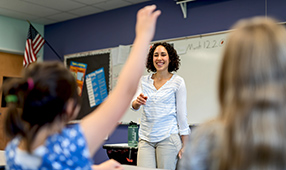Keeping students’ enthusiasm for school alive in the second half of the year can be a struggle, particularly as snow days, standardized testing and spring fever begin to take their toll. First-grade teacher Jessica Meacham knows this scene, and notes that it’s not just students who start to lose their fire—educators, too, begin to slump as the year pushes on. But she also knows she can’t afford to slack off. “It is essential that I show my energy and enthusiasm for every part of our day,” says the Door County, Wisconsin, teacher. “If I lose my excitement and energy, students may lose theirs, too.”
Little things can go a long way toward boosting your students’ interest in school. To help you keep things fresh through the second half of the school year, we gathered eight teacher-tested tips for rebooting your classroom:
1. Get student buy-in. To help students stay excited about learning, consider a thematic integrated unit on a topic that your students will grab on to, says Deanna Jump, an education blogger and kindergarten teacher. “Brainstorm a list of topics as a class and then take a class vote on the ones that seem to get the most interest,” she says. “When students are excited about what they are learning the amount of time spent on behavioral disruptions goes down and student learning goes way up.”
2. Hand over responsibilities. Starting mid-year, Wisconsin teacher Lisa Mattes puts her students in charge of handing out daily warm-up materials, changing the daily and monthly calendar, and delivering items to other teachers as needed. “They feel so official and grown up when put in charge,” she says. “They start looking for more things they can be responsible for and it is win-win.”
3. Mix up the routines. Think about your routines and how they might be changed up a bit, Meacham says. Her students receive a new format for their independent reading recording sheets in January, switching from paper to postcard. “The change keeps their interest and might even spark a renewed sense of purpose for the activity,” she says. You can also change seat assignments or the way students line up for lunch.
4. Offer brain breaks. Incorporate yoga type stretches, jogging in place or jumping jacks when you have a minute to spare, Mattes advises. If you have 3-5 minutes, use a brain break video. “They’ve been so helpful during the Polar Vortex we’ve had in Wisconsin,” Mattes says.
5. Introduce new books. Make time to read aloud to students and introduce new books. Each January, The American Library Association announces its Newbery, Caldecott, Siebert and other literary awards. Jump advises teachers to think about how they can incorporate such high-quality literature into their core lessons to keep things fresh.
6. Redecorate and rearrange. Meacham likes to shifts the classroom around mid-year. She advises teachers to think about flipping the layout of two classroom areas, such as the classroom library and the guided reading area, or introducing some new design elements, such as a plant or a new lamp. Students will notice the changes. And get students involved in the design decisions. “Let them have some input into the changes that are made,” Jump says. “If there is often a traffic jam at the cubbies, have the kids help brainstorm ways that this problem can be alleviated.”
7. Clean up your space. By mid-year, your classroom clutter has likely piled up. Meacham has a dusting, purging and organization “party” over winter break. “Afterward, I feel more prepared and ready for the second half of the year, and I am less prone be distracted by paper piles and dust, leaving my focus on where it should be—my students,” she says.
8. Find a PLN. Turn to Facebook, Pinterest and education blogs to find a personal learning network (PLN). These platforms allow you to stay current and find best practices in educational technology and instruction, Meacham says. You can also get great ideas for lessons, bulletin boards and classroom organization. Meacham and Mattes recommend the following Pinterest sites for teachers:












